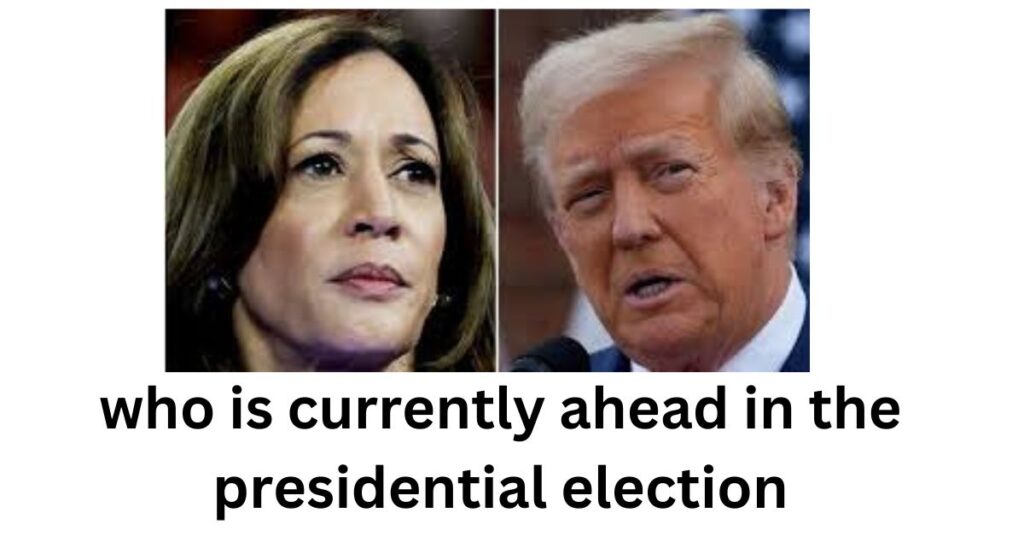Who is Currently Ahead in the Presidential Election?
The race for the presidency is always a high-stakes battle, with political tensions running high and supporters eagerly waiting for any signs of victory. The question on everyone’s mind right now? Who’s ahead in the polls, and what does it mean for the country’s future?
How are Polls Conducted?
Let’s start with the basics. Election polls are like snapshots in time—they capture public sentiment at that very moment, but they’re not necessarily predictive of the final outcome. Pollsters gather data through surveys, calling or texting thousands of potential voters to get a sense of how they’re leaning. Factors like demographics, political affiliation, and previous voting patterns all come into play. Still, polls can swing wildly and might not fully reflect who’ll actually head to the polls on Election Day.
The Front-Runners: Who’s Leading in the Polls?
In this election, we have a handful of prominent candidates vying for the top spot. Each one brings their unique approach and vision, appealing to different parts of the electorate. Right now, the race can change by the week, and sometimes, by the day. Major news outlets like CNN, Fox, and Reuters regularly update their poll tracking, but each source can show slight variations depending on the polling firm and methodology. At this point, it’s important to look at an average across polls to get a realistic picture.
Analyzing Key States: The Deciders of Victory
Some states, often referred to as “swing states” or “battleground states,” are pivotal in determining the outcome. States like Pennsylvania, Florida, Michigan, and Wisconsin tend to hold substantial sway due to their history of voting differently in each election cycle. When a candidate gains traction in these states, it can dramatically shift the projected path to victory. If one of the candidates is significantly ahead in these areas, that’s often a strong indicator they’re holding an edge in the race.
Trends and Shifts: Why Public Opinion Changes
Why do polls fluctuate so much? Public opinion isn’t set in stone. Various factors like debates, major news events, and campaign strategies can sway voters’ minds. A standout debate performance can provide a noticeable bump, while a scandal or slip-up might lead to a steep drop. Similarly, endorsements from influential figures or high-profile campaigns on social media can bring about significant shifts in a candidate’s favor.
How Reliable Are These Polls?
While polling is the best tool we have to gauge public sentiment, it’s not foolproof. In recent elections, we’ve seen some discrepancies where the polls didn’t entirely capture the actual voter turnout or sentiment, leading to surprises. The unpredictability of voter turnout, particularly among younger or first-time voters, adds another layer of complexity. Some polls may lean left or right, depending on who they’re surveying, so it’s crucial to consider a broad range of polling data rather than putting too much stock in any single source.
What Are Key Indicators to Watch?
Several metrics give us insight into a candidate’s chances of winning. One of the biggest indicators is the candidates’ favorability rating, which measures how positively the public views each person. A candidate with high favorability but trailing in policy-specific questions can still make a strong showing. Additionally, voter enthusiasm—the passion of a candidate’s base to actually show up and vote—often makes or breaks elections. Another aspect to monitor is fundraising numbers; the more funding, the more resources to reach undecided voters.
The Role of Campaign Strategy and Media
A solid campaign strategy often plays a significant role in polling trends. Candidates with strong digital outreach, strategic advertising, and positive media coverage generally do well in polls. The media’s influence can’t be underestimated—every sound bite, interview, and tweet can sway public perception. Even a single moment can go viral, leading to shifts in favorability almost instantly.
What’s the Public’s Main Focus?
At this point, specific issues are defining the race. Topics like the economy, healthcare, and national security are at the forefront, and each candidate is tailoring their message to address these concerns. Candidates who align closely with voters on these priority issues tend to perform better in the polls. People are also watching closely to see how candidates handle crises or respond to breaking news, as these moments reveal much about their decision-making style.
The Bottom Line – Who’s Leading Today?
While it’s clear that some candidates have an edge, elections are dynamic. The key takeaway here is that being “ahead” in the polls doesn’t guarantee a win. Polls reflect tendencies, not certainties. For the candidates, it’s a balancing act, and every week counts. The race remains fluid, and as Election Day approaches, we’ll likely see further shifts.
Conclusion
The journey to the presidency is a marathon, not a sprint. While polls give us a glimpse of where things stand today, there’s plenty of time for shifts, surprises, and last-minute changes. So, if you’re following the race closely, remember: every vote counts, and the real result won’t be revealed until Election Day.
The Role of Undecided Voters – Will They Tip the Scales?
One of the biggest wild cards in any election is the group of undecided voters. These are the people who, up until Election Day, aren’t fully committed to any candidate. In many cases, they make up their minds only after the final debates or even on Election Day itself! Undecided voters often lean toward the candidate they feel most aligns with their values or one who speaks directly to their concerns. So, how important are they? Extremely! In tight races, undecided voters can truly make or break a candidate’s chances.
Young Voters and First-Timers – Are They Showing Up?
The youth vote is notoriously unpredictable. Young voters are often passionate about key issues like climate change, social justice, and affordable education, but historically, their turnout rates are lower compared to other age groups. This year, there’s a lot of focus on mobilizing young voters, with campaigns heavily targeting social media platforms like TikTok, Instagram, and Twitter. Will these efforts pay off? If there’s a high turnout among younger voters, it could significantly shift the outcome, especially in battleground states.
Voter Turnout Predictions – What’s Expected?
Turnout predictions are always a bit of a guessing game, but political analysts look at several factors to make educated guesses. Excitement around candidates, high-stakes issues, and previous voter registration trends can all indicate how many people will actually make it to the polls. High turnout often benefits one party over the other, depending on the demographics of the voting bloc that’s most motivated. Will we see record-breaking numbers this year? If history is any indicator, a competitive election often brings out a wave of voters.
Economic Factors – A Deciding Force?
When it comes down to it, many voters are concerned with one thing: their pocketbooks. The economy is a constant topic, from job security and inflation to housing costs and tax policies. Historically, a strong or weak economy heavily influences public opinion. If people feel financially secure, they may lean towards the candidate who promises to maintain the status quo. On the other hand, economic instability or rising living costs might push them toward a candidate promising change. Right now, economic indicators are a mixed bag, creating an uncertain impact on the election.
Social Media and Influence – Where Voters Are Watching
In today’s digital age, social media plays a pivotal role in elections. It’s the primary way many voters, especially younger ones, consume information and form opinions. Campaigns know this and invest millions in targeted ads and content that aim to go viral. From memes to video clips of debates, social media isn’t just for entertainment; it’s become a battleground where candidates vie for attention. Candidates’ digital teams work around the clock to craft messages that resonate, and sometimes a single tweet or viral video can sway public sentiment significantly.
What About International Perspectives? The World is Watching
Believe it or not, the U.S. election is a global affair. International leaders, businesses, and even the average global citizen closely watch these elections because the outcome affects foreign policy, global markets, and international relations. A change in leadership could lead to shifts in trade agreements, climate policies, and global security alliances. So, while Americans cast their votes, there’s an entire world waiting to see the result and what it means for their futures, too.
Final Stretch – The Importance of Ground Game
In the last few weeks before Election Day, candidates focus on mobilizing voters. This is where the “ground game” comes into play. Volunteers and campaign workers hit the streets, knock on doors, and make phone calls to remind supporters to vote. This grassroots approach, which may seem old-school in today’s digital age, is still incredibly effective. The ground game can be the difference between winning or losing a critical state, and for close races, it’s all hands on deck to get every last vote counted.
Preparing for Possible Outcomes – What’s at Stake?
Election night can be intense, and the results might not be clear right away. Close races may require recounts, and disputes over voting irregularities can lead to legal battles. While we hope for a straightforward outcome, history has shown that the final result isn’t always immediate. Knowing this, campaigns prepare for multiple scenarios to navigate a potentially contested outcome.
Conclusion: The Power of Your Vote
As we approach Election Day, remember that every vote counts. While polls and projections paint a picture, the ultimate power rests in the hands of the voters. Whether you’re passionate about a candidate, the issues at stake, or simply want your voice heard, showing up to vote is what really decides the election. So, stay informed, stay engaged, and make your voice count—because at the end of the day, it’s the voters, not the polls, who choose the next leader of the nation.


